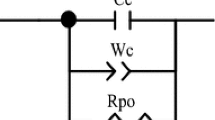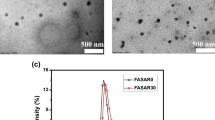Abstract
Cathodic electrodeposition (CED) behavior and film properties of coating binders as modified polyepoxide resins based on cardanol, a constituent of Cashew Nut Shell Liquid (CNSL), have been studied. These coating binders were synthesized by epoxidation of cardanol–formaldehyde novolacs (CNs) with epichlorohydrin and subsequently modified with secondary amine to make them water-thinnable by neutralization with acetic acid, and suitable for CED. Laboratory synthesized coating binders, modified, epoxidized cardanol–formaldehyde novolacs (MECNs), were cathodically electrodeposited on pretreated MS panels to investigate their electrodeposition behavior and film properties of deposited coating binders. Among the nine MECNs prepared by varying molar ratios of cardanol to formaldehyde as well as ECN to DEtOA, only seven MECNs (MECN1, MECN2, MECN3, MECN6, MECN7, MECN8, and MECN9) were water-soluble and electrodepositable, whereas MECN4 and MECN5 were not water soluble, and hence not considered for further studies. These seven MECNs were used for the study of their electrodeposition characteristics, such as electrodeposition yield (ED yield), coulombic yield (CY), dry film thickness (DFT), and properties of their deposited films. The most suitable molar ratio of ECN:DEtOA for the preparation of MECNs was found to be 1:1. The CN prepared by using cardanol and formaldehyde in the molar ratio of 1:0.7 was used for the preparation of ECN2 and MECN2 prepared from this was found to be the most suitable in terms of deposition behavior and overall film properties. The film of MECN2 electrodeposited at constant voltage (100 V) was found to be the best in terms of film properties along with corrosion resistance, as it passed 800-h exposure to salt spray atmosphere. MECN2 was optimized for its electrodeposition characteristics like ED yield as 3.62 mg/cm2, CY as 35.87 mg/C, and DFT as 25.26 μm. Through a wide cure window, the films of MECN2 were found to be self-curable at an optimum cure schedule of 160°C/30 min. The electrodeposited films of MECNs had good physical, chemical, and corrosion resistance properties, but demonstrated low resistance to xylene, in particular. The study emphasized the electrodeposition behavior and film properties of the prepared MECN resins as binders for CED coating formulations, which were self-curable without using any external crosslinker. The self-curing of the deposited films was achieved via a novel self-curing mechanism, i.e., one molecule chemistry through anionic polymerization. The prepared epoxide resins as MECNs could be cathodically electrodeposited as primer coat for the protection of metallic substrates against corrosion.










Similar content being viewed by others
References
Brewer, GEF, “Coatings, Electrodeposition.” In: Kroschwitz, JI (ed.) Encyclopedia of Polymer Science and Engineering, 2nd ed., Vol. 3, pp. 675–687. Wiley Interscience Publication, New York (1985)
Kordomenos, PI, Nordstrom, JD, “Polymer Compositions for Cationic Electrodepositable Coatings.” J. Coat. Technol., 54 (686) 33–41 (1982)
Paul, S, Surface Coatings—Science and Technology. Wiley, New York (1985)
Oil and Colour Chemists’ Association, Australia (Prepd.), Surface Coatings, Vol. 2—Paints and Their Applications, 2nd ed. Chapman and Hall, London, 1984
Wismer, M, Pierce, PE, “Cathodic Electrodeposition.” J. Coat. Technol., 54 32–44 (1982)
Sakai, S, Arai, K, Yamakawa, K, “Epoxy Resin-Containing Cathodic Electrodeposited Paints.” Japanese Patent 2004123942, 2004
Shirakawa, S, Takekawa, M, Yamada, M, “Epoxy Resin-based Cathodic Electrodeposition Paint Composition with Low-temperature Harden-Ability and Durability.” Japanese Patent 2002294141, 2002
McIntyre, JM, Anderson, KW, Rao, NA, Hickner, RA, “Corrosion-resistant, Low-Temperature Cured Cathodic Electrodeposition Epoxy Coatings Containing Blocked Isocyanate Prepolymer Crosslinkers, and Their Application.” European Patent 0304834, 1989
Balakrishna, RS, Venkateshwarlu, D, Sathyanarayana, MN, Shirsalkar, MM, “Role of Blocked Phenyl Isocyanates on Cathodically Electrodepositable Binders Based on Epoxy Resins.” Paintindia, 39 (12) 61–63 (1989)
Fujibayashi, T, Kasukawa, T, Morimoto, K, “A Novel Binder Suitable for Cationic Electrodeposition Coatings Based on a Non-Isocyanate Chemistry.” Prog. Org. Coat., 22 231–244 (1993)
Mythili, CV, Retna, AM, Gopalakrishnan, S, “Synthesis, Mechanical, Thermal and Chemical Properties of Polyurethanes Based on Cardanol.” Bull. Mater. Sci., 27 (3) 235–241 (2004)
Chuayjuljit, S, Rattanametangkool, P, Potiyaraj, P, “Preparation of Cardanol–Formaldehyde Resins from Cashew Nut Shell Liquid for the Reinforcement of Natural Rubber.” J. Appl. Polym. Sci., 104 (3) 1997–2002 (2007)
Sun, R, Liu, M, Chen, X, Liu, Y, Wang, Z, Li, X, “Cardanol-Modified Phenol Formaldehyde Resin Composition and Fireproofing Paper-Based Copper Clad Laminate.” Chinese Patent 101265352, 2008
Pan, J, “Thermosetting Cardanol–Formaldehyde Resin with Extraordinary Compatibility and Complementarity with Non-Polar Rubber.” Shanghai Tuliao, 47 (11) 37–40 (2009)
Paramashivappa, R, Kumar, PP, Vithayathil, PJ, Rao, AS, “Novel Method for Isolation of Major Phenolic Constituents from Cashew (Anacardium occidentale L.) Nut Shell Liquid.” J. Agric. Food. Chem., 49 (5) 2548–2551 (2001)
Gopalkrishnan, S, Linda Farnando, T, “Processability and Characteristics of Novel Polyurethanes from Cardanol.” Res. J. Pharmaceut. Biol. Chem. Sci., 1 (4) 252–261 (2010)
High Production Volume Chemicals, “Screening-level Hazard Characterization of High Production Volume Chemicals—Cashew Nutshell Liquid (CAS No. 8007-24-7).” Risk Assessment Division, Office of Pollution Prevention and Toxics, Environmental Protection Agency, Washington DC, October 2007
Pillai, CKS, “Liquid Crystalline Polymers: The Effects of Chain Disruptors.” Pure Appl. Chem., 70 (6) 1249–1252 (1998)
Hindustan Organic Chemicals Limited. http://www.hocl.gov.in
Beck, F, “Electrodeposition of Paints in Comprehensive Treatise of Electrochemistry.” In: Mbockris, JO, Conway, BE, Yeager, E, White, RE (eds.) Electrodeposition of Paint, Vol. 2, pp. 537–569. Plenum, New York (1981)
Oldring, PKT, A Manual for Resins for Surface Coatings, Vol. 3. SITA Technology, London (1987)
Beck, F, “Fundamental Aspects of Electrodeposition of Paints.” Prog. Org. Coat., 4 1–60 (1976)
Miskovic-Stankovic, VB, “The Mechanism of Cathodic Electrodeposition of Epoxy Coatings and the Corrosion Behaviour of the Electrodeposited Coatings.” J. Serb. Chem. Soc., 67 (5) 305–324 (2002)
ASTM D609-00, “Standard Practice for Preparation of Cold-Rolled Steel Panels for Testing Paint, Varnish, Conversion Coatings, and Related Coating Products.” In: Annual Book of ASTM Standards, 2006
Ranjbar, Z, Moradian, S, “The Effect of Molecular Weight of Epoxy Resin on the Deposition Behaviour of Water-Borne Epoxy-Amine Adducts.” Iran. Polym. J., 13 (1) 69–75 (2004)
Beck, F, “Electrical and Chemical Aspects of Electrodeposition of Paint.” In: Wilson, AD, Prosser, HJ (eds.) Developments in Ionic Polymers-2, pp. 329–349. Elsevier Applied Science Publications, London (1986)
Pierce, PE, “The Physical Chemistry of the Cathodic Electrodeposition Process.” J. Coat. Technol., 53 (672) 52–67 (1981)
ASTM D 523-99, “Test Method for Specular Gloss.” In: Annual Book of ASTM Standards, 1994
ASTM D 3359-93, “Test Method for Measuring Adhesion by Tape Test.” In: Annual Book of ASTM Standards, 1994
ASTM D 522-88, “Test Method for Mandrel Bend Test of Attached Organic Coatings.” In: Annual Book of ASTM Standards, 1989
ASTM D 3363-92a, “Test Method for Film Hardness by Pencil Test.” In: Annual Book of ASTM Standards, 1994
B S 3900, British Standard Methods of Test for Paints, Part E2, Gr. 2, 1966
ASTM D 2794-93, “Test Method for Resistance of Organic Coatings to the Effect of Rapid Deformation (Impact).” In: Annual Book of ASTM Standards, 1994
ASTM D 1308-87, “Test Method for Effect of Household Chemicals on Clear and Pigmented Organic Coatings.” In: Annual Book of ASTM Standards, 1994
ASTM B 117-94, “Test Method for Salt Spray Test of Organic Coatings.” In: Annual Book of ASTM Standards, 1994
Acknowledgments
The authors wish to express their gratitude to the All India Council for Technical Education (AICTE), New Delhi (India) for the financial assistance provided for running the project entitled “Development of eco-friendly and energy-efficient polymeric coatings for cathodic electrodeposition” under its TAPTEC scheme (AICTE File No. 8021/RID/NPROJ/TAP-12/2002-03). The authors also wish to thank Satya Cashew Chemicals Ltd., Chennai (India) for providing free samples of cardanol and CNSL for this study.
Author information
Authors and Affiliations
Corresponding author
Rights and permissions
About this article
Cite this article
Raju, Kumar, P. Cathodic electrodeposition of self-curable polyepoxide resins based on cardanol. J Coat Technol Res 8, 563–575 (2011). https://doi.org/10.1007/s11998-011-9337-y
Published:
Issue Date:
DOI: https://doi.org/10.1007/s11998-011-9337-y




